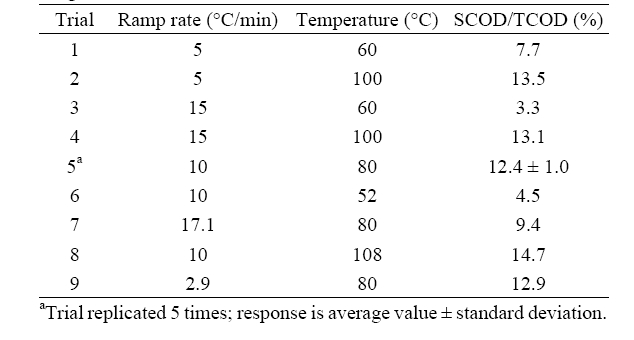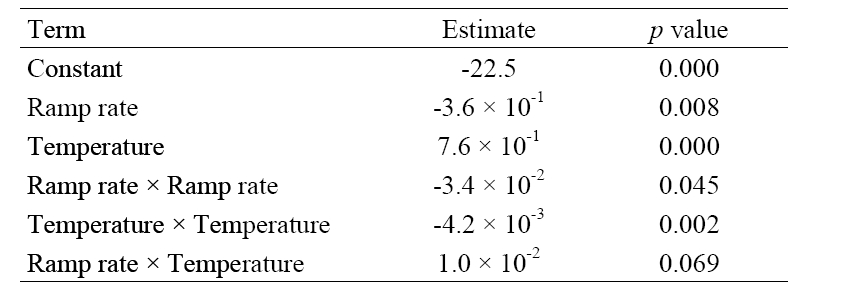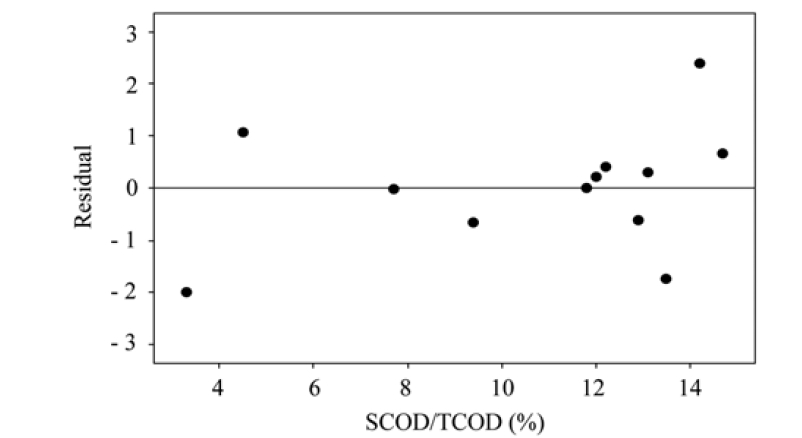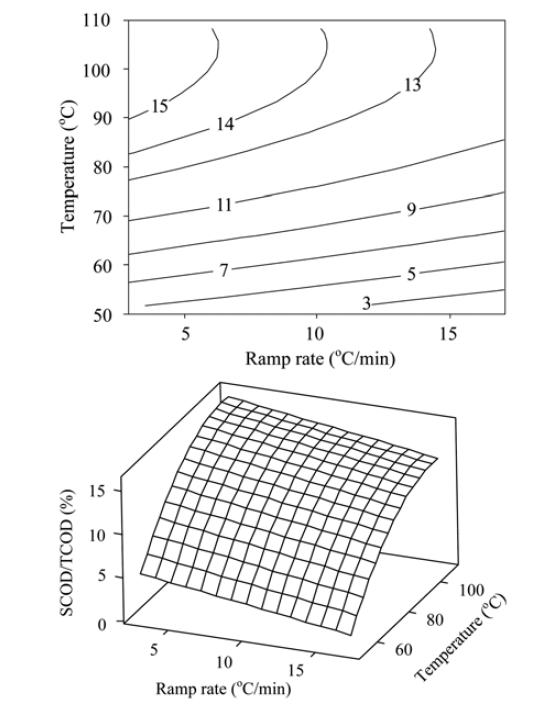


Solubilization of sewage sludge creates favorable conditions for anaerobic microorganisms to produce biogas. In this paper, we quantify the effect of heating pretreatment on the degree of solubilization of sewage sludge. The pretreatment process was carried out using a lab-scale industrial microwave unit (2450 MHz frequency). Response surface analysis was applied to determine the combination of temperature-increase rate (ramp rate) (2.9 to 17.1 ℃/min) and terminal temperature (52 to 108℃). Both ramp rate and temperature significantly affected the solubilization degree of sludge. Within the design boundaries, the conditions predicted to maximize the solubilization degree of 15.8% were determined to be 2.9 ℃/min and 104℃.
The processing and disposal of sewage sludge is one of the most important and complex problems in the operation of municipal wastewater treatment plants.1) Anaerobic digestion has long been used to treat sludge generated by the treatment of municipal and industrial wastewater. The main fraction of sludge consists of bacterial materials that commonly withstand direct anaerobic degradation because the cell walls from physical and chemical barriers to exoenzyme degradation and hydrolysis. Thus, the availability of intracellular organic material from feed cells is restricted, and long retention times of 20-30 days are required to reach moderate efficiencies of 30 - 50% in typical anaerobic digestion.2,3)
Anaerobic degradation of particulate materials and macromolecules is considered to occur in four steps: hydrolysis, acidogenesis, acetogenesis, and methanogenesis. In sludge digestion, hydrolysis is the rate-limiting step.4) To use particulates as a substrate, bacteria release extracellular enzymes that break down and solubilize organic particulate matter.5) To improve digestion efficiency, the most logical approach is to disrupt the microbial cells in the sludge. The disintegration of sludge has therefore been introduced to solubilize and convert slowly biodegradable, particulate organic materials to readily biodegradable low-molecular- weight compounds.6)
Disintegration of sludge may be performed mechanically, ultrasonically, chemically, or thermally. Mechanical pretreatment has been shown to be highly effective in solubilizing microbial cells, although the process is complicated and expensive.1) Sonication is effective in disintegrating 70-100% of sludge cells, but this approach is energy-intensive. Chemical and thermochemical pretreatments, based on strong acidic or basic conditions in combination with high temperatures and pressures, are efficient in enhancing sludge digestion,7) but the aggressive reaction conditions commonly require the use of specialized materials. The high costs of wet sludge disintegration, in addition to corrosion problems and limited knowledge of the process itself, prevent this approach from achieving its potential as an anaerobic process1); consequently, an effective and economical pretreatment is essential.
Microwaves are used in many and varied applications, including organic decomposition, sterilization of medical waste, and inactivation of microorganisms in foods, animal manure, and soil.8) The advantages of microwaves in these applications include rapid heating, pathogen destruction, ease of control, compactness, and low overall cost.9) Destruction of microorganisms is generally thought to occur due to the thermal effects of microwave exposure, although several researchers have investigated whether such irradiation also has a non-thermal effect.10) The application of microwave fields can cause polarized side-chains of macromolecules to align with the direction of the electric field, leading to the possible breakage of hydrogen bonds and alteration of the hydration zone.8) The principal factors of microwave radiation that affect dielectric materials include temperature, radiation time, output power, and penetration depth.8)
When multiple factors and interactions affect a response of interest, response surface analysis (RSA) is an effective tool for optimizing the process. RSA is a collection of mathematical and statistical techniques for building empirical models.11) The main advantage of RSA is the reduced number of experimental trials needed to evaluate parameters and their interactions. Therefore, it is less laborious and time-consuming than other approaches required to optimize a process.12)
Currently, information is lacking concerning the effects of pretreating sludge with microwaves. Therefore, the objective of this study is to investigate the effects of microwave irradiation on solubilization of sewage sludge.
Primary and secondary sludges (Table 1) were obtained from a municipal wastewater treatment plant in Chuncheon, Korea. The ratio of volatile solid (VS) to total solid (TS) in the sludges, 62-67%, indicated that the sludges consisted mainly of organic substances. Most of the chemical oxygen demand (COD) was associated with the solid phase rather than soluble phase, as evidenced by the low soluble COD (SCOD) to total COD (TCOD) ratio of 2.3-2.8% (Table 1).
In a preliminary trial (data not shown) the solubilization degree was increased as the ratio of primary sludge to secondary sludge increased (p < 0.05). However, the primary and secondary sludges were produced in all wastewater treatment plants at the same time and can be treated in an anaerobic digester. Therefore, the sludges were blended (50:50 v/v) to analyze the effects of microwave pretreatment on solubilization without considering the ratio of both sludge production (Table 1).
To study the microwave effects on sewage sludge we used a Microwave Accelerated Reaction System (MARS, CEM Corporation, 0-1600 W power output, 2450 MHz frequency, 102 atm maximum pressure, temperature range: 0-330℃) equipped with temperature and pressure sensors within the cavity and a turntable with pressure-sealed vessels (Omni) of 100 mL each (Fig. 1). Samples (70 mL) of sewage sludge were pretreated in a vessel rotating on the turntable. After target temperatures (52℃ to 108℃) were reached, samples were removed from the heating source, allowed to cool to room temperature and then stored at 4°C in a refrigerator.
2.3. Analysis of Sewage Sludge Solubilization
In a preliminary trial (data not shown) that analyzed the effects of terminal temperature, temperature-increase rate (ramp rate), holding time, and output power on sludge solubilization, the holding time did not have a significant effect (
[Table 1] Characteristics of sewage sludge

Characteristics of sewage sludge
[Table 2] Experimental conditions and results of the central composite design

Experimental conditions and results of the central composite design
rates by microwave irradiation.
RSA was used to determine the relationship of the sludge solubilization to ramp rate and temperature. It was applied to evaluate the relative significance of the environmental factors and to determine the conditions under which solubilization of sludge is maximum within the experimental range of the independent variables.
The experiment (Table 2) was based on the central composite design11) and consisted of a 2 × 2 (ramp rate × temperature) orthogonal design augmented by 5 replicates at the center point. Conditions at the center point were ramp rate = 10 ℃/min and temperature = 80℃. Repeat observations at the center point were used to estimate the experimental error.
A sequential procedure of collecting data, estimating polynomials, and checking the adequacy of the model was used. The method of least squares was used to estimate the parameters in the approximating polynomials. Minitab 15 (Minitab Inc., USA) was used to establish the experimental design and to test complex polynomials to model the data.
All measurements were duplicated, and the results given are mean values. The COD and solid concentrations were determined using standard methods.13)
3.1. Disintegration and Solubilization Effect of Microwave Pretreatment
We hypothesized that microwave irradiation would disrupt the complex activated sludge floc structure and release extracellular and intracellular biopolymers such as proteins, carbohydrates, and lipids into the soluble phase, and that it would enhance the solubilization of organic particulate matter.14,15) The degree of solubilization of the substrate can be estimated from the SCOD to TCOD ratio (SCOD/TCOD, %). SCOD/ TCOD values in the pretreated sludge were clearly higher than that in the raw sludge (Tables 1 and 2), thereby indicating that microwave irradiation had a strong effect on sludge solubilization.16)
In Trial 8 (ramp rate = 10 ℃/min; temperature = 108℃), SCOD/TCOD (14.7%) was the highest among the 13 trials (Table 2). The SCOD concentration increased from 379 ± 4 mg/L to 1,930 ± 143 mg/L and SCOD/TCOD increased from 2.6% to 14.7% (Table 2) in Trial 8; these values are comparable with the results of other studies.14,15,17-20) At a given temperature, SCOD/TCOD increased as ramp rate decreased (Table 2).15,18)
Comparison of SCOD/TCOD gives a general indication of the extent of hydrolysis. In this study, SCOD/TCOD increased from 2.6% (control) to 3.3-14.7% after microwave pretreatment to 52-108°C. Solubilization of sewage sludge due to microwave irradiation has been previously reported; depending on conditions, reported SCOD/TCOD after microwave pretreatment temperatures (50℃ to 175℃) have ranged from 12% to 35%.14,15,17-20)
3.2. Response Surface for the Solubilization of Sewage Sludge by Microwave Irradiation
A total of 13 trials, including a center point, were run to approximate the response surface for the solubilization of sludge by microwave irradiation (Table 2). First, 9 trials were run. A first-order model, ηi = β0 + βx1 + βx2, was attempted to fit the data by least squares and the following model (equation 1) was obtained.
where η = experimental value of the solubilization degree (SCOD /TCOD, %), and xi = independent variable
When the data analyzed using the model, equation 1 was significant (
Additional trials were conducted to locate the maximum conditions for the solubilization more precisely. A second-order model could not be fit using the data from Trials 1 to 5 in Table 2 due to the lack of axial data points. An additional 4 trials (from Trials 6 to 9 in Table 2) were augmented with previous trials to make a central composite design.
To find the maximum solubilization degree of the sludge, increasingly complex equations from linear to quadratic were sequentially tested with theses augmented trials. Equations 2-4 represent linear, interaction, and quadratic models, respectively:
Lack of fit was not significant (
An analysis of variance using equation 4 was initially performed to investigate the possible interaction between variables (Table 3). The interaction between the variables, ramp rate × temperature, was not significant (
[Table 3] Analysis of variance for linear and square variables and their interaction

Analysis of variance for linear and square variables and their interaction
Equation 5 was highly significant (
Two- and three-dimensional response surfaces of the quadratic model for the solubilization degree of sludge (Fig. 3) showed that the optimum condition was inside the design boundary only for temperature. At all temperature within the design boundaries SCOD/TCOD increased constantly as ramp rate decreased.
RSA was successfully applied to determine the effects of ramp rate and terminal temperature on the solubilization degree of sewage sludge and to estimate the response surface describing the solubilization degree to changes in these variables. In the model, both ramp rate and temperature affected the solubilization degree significantly (





